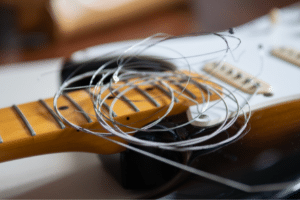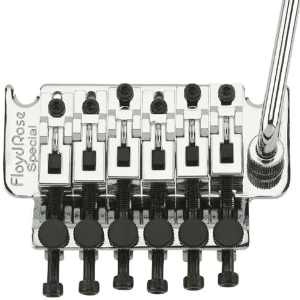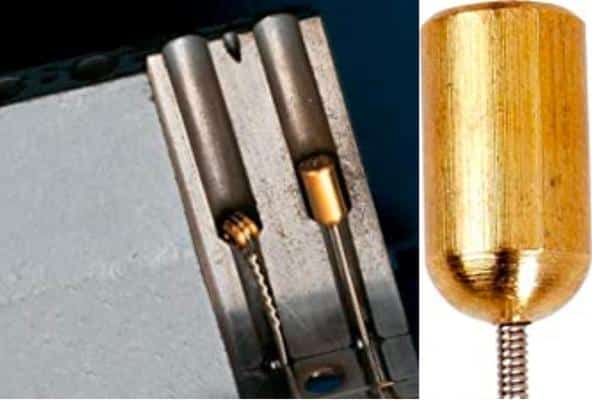
One of the most frequent questions about replacing guitar strings I get is what to do if one breaks while you’re playing, change only the one, or replace them all? The short answer is that it depends on the particular circumstances, but here are some tips, tricks, and helpful hints that will prepare you for the unexpected!
You can use the table of contents below to take you to the area that interests you. Click on the little box to open it and then click on the section of the article you want to read, or you can read from start to finish if you want the full string-changing experience!
So, What’s The Right Answer?
The truth is, there isn’t one. I’m sure you will agree that it depends on what you’re doing when a string breaks and the age or condition of the strings. Most of us have had a string break at the worst possible time during that big guitar solo or recital.
If you’re lucky enough to break a string during a practice setting, you have more options at your disposal.
Here are some tried and true strategies to help you deal with that unexpected broken string.
During A Performance
No one wants to stop the show while everyone watches you replace or repair a broken string! If you play pro, the best approach is to have a backup guitar, especially if you do a lot of string bending or use a guitar with a floating vibrato bridge. This also allows you the luxury of replacing the string or entire string set at a more convenient time.
The other option is to try to finish the song without the string, which can be tricky if you play complex chord progressions or melodic passages. But, it can be done if you know your guitar neck. What if you break one of the “middle strings,” like the A, D, or G? Nothing will save you from that disaster unless you are a guitar prodigy!
While Practicing With Your Band
If you break a string while practicing with your band, your best option is usually to quickly replace just the one. Always remember to keep extra strings in your guitar case, ideally an entire set, but at least extra high-E, B, and G strings, plus a string winder to make the job go faster.
Most players that try to quickly repair a string fail miserably, especially if it breaks, and the little end-piece that holds it in the guitar bridge(aka brass wire ball end) is nowhere to be found!
If You Are Playing At Home
This is the best-case scenario because although it interrupts your practice session, it allows you to change it at your convenience. It might just give you the little break you needed in the middle of your practice session.
It’s also a better time to decide if you should change the entire set and clean your guitar while you’re at it. If your string set is old and you have a replacement, definitely go for it! The home string breakage scenario gives you the luxury to take a look at your guitar and make “decisions after the fact” before you take action.
Decisions After The Fact (Why Did The String Break?)
What happens after the heartbreak of a single-string mishap is another story. Some players simply move on and let “bygones be bygones.” I recommend you take a close look at your guitar and decide what, if anything, needs to happen next. Taking a troubleshooting approach is one of the best ways to avoid it from happening again!
So, why did the string most likely break?
- Was that string defective, or is the set old and worn out?
- Is your string gauge too thin for your playing style?
- Is there a problem with your guitar or how it’s set up that caused it to break?
- Did a dirty guitar neck cause a gunky string buildup that corroded the metal?
- Do you have sweaty hands and need to wipe them and your strings between sets?
Read more in the section below on “Guitar Problems That Break Strings.”
Should You Repair A Guitar String?
I generally don’t recommend repairing a guitar string unless there are no other performance options or you don’t have the money to buy a new one. Also, remember that the fix is only temporary.
Repaired strings never sound the same. A guitar string develops certain “bends and kinks” when it is initially strung on an instrument. If the string is removed, repaired, and restrung, new bends and kinks form, and the old ones never really away or line up the same way. This will most likely affect the string’s normal vibration and degrade the tone.
Strings that have been repaired can damage your guitar, depending on the circumstances! For example, if a string is repaired where it lies over the guitar neck, it can damage a fret or the surface of the fingerboard.

Guitar Problems That Break Strings
Here are some of the most common guitar parts that can break a string.
Tuning Machines
Faulty tuning machines, especially tuning post holes with sharp edges and locking tuners with pin problems, can weaken a string and cause it to break at that point.
String Trees
Friction between a string tree and the string can cause string pitting as it moves back and forth when tuning or using a whammy bar. To correct the problem, lubricate the string tree(s), install graphite replacements, or get a locking nut.
Nut
Sharp edges or burrs in a nut’s string slots that are not filed or angled correctly can damage your strings. If you use a thicker string gauge, the nut slots may need to be enlarged to prevent the strings from binding, which can damage the strings and cause problems with tuning and intonation.
Applying graphite to the nut slots or installing a self-lubricating nut can definitely help.
If you are thinking about replacing your nut, check out my article on TUSQ XL Nut Review – Make Your Guitar Sing Like A Canary!
Bridge Saddles
Bridge saddles with burrs or sharp edges can cause string breakage, especially during whammy bar use. It’s essential to adjust the saddles correctly. Lubricate them where they contact the strings or replace them with graphite saddles.
Some players put a short piece of plastic wire insulation over the string where it sits on the bridge saddle. This may help reduce string breakage but can worsen your tone.

Vibrato Bridges – A Broken String Nightmare!
If your guitar has a vibrato bridge that is set up to “float” (move in both directions to raise and lower the pitch of the strings), breaking one string will throw all the remaining strings out of tune due to the change in string tension on the bridge.
Unless your guitar has a bridge lock, to return it to its original position and put the remaining strings back in tune, you will need to stop playing until the broken string is replaced and the guitar is re-tuned, which can take quite a while! This delay is unavoidable, even if you have a double-locking tremolo.
The moral of the story: Always have a backup guitar if you use a whammy bar!
How Long Do Guitar Strings Last?
The answer depends on three main factors.
Your Guitar
More expensive guitars can be easier on strings than those with cheaper hardware. Keeping your guitar (and strings) clean and properly set up can also help. If you keep breaking the same string, your guitar may have a problem, most likely with a sharp edge or burr on the bridge saddle.
The Strings You Use
The brand, model, and gauge (thickness) of the strings you use can all make a difference. Low-quality strings can break easier and may not sound as good. If your high-E string keeps breaking, it is probably too thin for the amount it is being bent.

For example, Fender Bullet strings have ends (bullets”) soldered to the string instead of twisted on. They have a shape that fits perfectly into the tremolo block string channel without twisting when the whammy bar is pressed down. Therefore, they stay in tune better and are less prone to breaking.
Coated strings are corrosion-resistant to prevent surface pitting. They extend the life of the strings and help preserve their tone.
How Often You Play And Your Playing Style
The longer you play, the quicker your strings will wear out and develop irregularities that can cause them to break. If you have an aggressive playing style that involves picking hard (“digging into the strings”), wide (1 ½ to 2 step) bends, and giving the whammy bar a real workout, you will be more likely to break strings.
How To Avoid Breaking Guitar Strings
- Keep your strings clean and dry
- Change them when they are old or sound bad
- Use thicker gauge strings, especially if you bend notes or use a whammy bar
- Keep your guitar clean, especially the frets and fingerboard
- Have your guitar inspected and set up regularly
What To Do When Disaster Strikes!
All players will eventually experience the frustration of a broken string, no matter what genre of music they play. A guitar string can break when you least expect it and when it’s least convenient. The most important thing to remember is not to panic or get visibly angry, especially if you’re playing in front of an audience.
Try to play on the remaining strings you have left until the song is finished. If you need to stop playing to restring your guitar, have the band continue without you or play something totally different in your absence. Remember, the show must go on!
When time permits, try to figure out why the string broke. I may not have been from string aging or wear and tear. If it is something correctable, like hardware adjustment or replacement, you may be able to prevent the string from breaking again.

String Replacement Checklist
Here are the things I recommend you keep in your guitar case, especially if you play out, for fun and professionally.
- New guitar strings
- A complete set (ideally)
- Single replacement strings: G, B, High-E (most likely to break)
- A complete set and single replacements (great but unnecessary)
- Microfiber cloth
- Fretboard cleaner (the proper type for your guitar neck) or an all-purpose cleaner
- String winder (a small manual peg winder is fine)
- Wire cutter (optional, you can cut off the extra string length later or not at all)
- Guitar tuner (clip-on is best – guitar doesn’t need to be plugged in)
- Needle nose pliers (to help remove or repair a string if you don’t have a replacement

Advantages Of New Strings
- More difficult to break
- Easier to keep clean
- Sound bright, crisp, and toneful
- Less string buzz
- Better note harmonics
- Longer sustain
- Easier to stay in tune
- Better intonation
- Less fret wear

Disadvantages Of Old Strings
- Easier to break
- Harder to keep clean
- Loose tone and sound dull
- Harder to stay in tune
- Can cause problems with intonation
- More difficult to bend
- Less sustain
- Can wear down frets faster

Beware Of Mixing String Types
Although it’s fine in an emergency, you should try to have replacement strings that match the type you already have on your guitar, especially for the wound strings.
Ideally, your replacement strings should be the same brand and model you typically use, so you can keep them on your guitar until you decide to change the entire set. You won’t notice much difference (if any) with the G (unwound), B, and high-E strings.
With the wound strings, it’s better not to mix different string types. For example, a low-E pure nickel wrap string will sound different than a low-E string with a nickel-plated steel wrap; or using a flat-wound low-E in place of a round wound low-E.
If you use a Drop tuning string set on your guitar, it’s important to have an exact backup replacement for each string, especially if your guitar has a whammy bar!

Frequently Asked Questions
Here are some of the questions I get asked about guitar strings.
If your question does not appear here, please put it in the comments, and I will get right back to you with an answer.
Is Replacing A Guitar String Easy?
It is pretty straightforward once you learn how to do it properly and become experienced. You may find your first time a little tricky, but your second attempt will be much easier.
How Long Does It Take To Restring A Guitar?
It can take more or less time, depending on how many strings you have to change and the kind of guitar you have. For example, locking tuners make it quick and easy to change strings, whereas a locking nut with a locking tremolo takes longer.
How Do I Know What Size Guitar Strings To Buy?
Unless you want to put thinner or thicker strings on your guitar, buy the same size strings that the guitar is currently stringed with. If you don’t know what size they are, you can bring the guitar to a music store where they can measure them for you and provide you with a new set. Keep the string package for future size reference.
Be aware that if you change your string gauge (size), you may have to get your guitar re-adjusted to accommodate the change in string tension.
How Do You Know Which String Goes Where?
On a typical six-string guitar, the string order is E, A, D, G, B, E. So; there are two E strings, a thick one (low-E) and a thin one (high-E). The low-E string goes at the top of the neck (closest to your chest), and the high-E goes at the bottom (closest to your legs). The names of each string are written on the string envelope
Do New Strings Need Time To Settle?
Yes, they can take hours to days or even weeks to adjust to the guitar, depending on how much you play it. Stretching each new string with your fingers will drastically reduce the time they need to settle and stay in tune.
Does It Matter What Order You Restring A Guitar?
No, but It’s easiest to replace them in order from low-E to high-E or high-E to Low-E. Starting from the thickest string may be easier if you are a beginner.
How Often Should You Replace Guitar Strings?
If a string is not broken or damaged, you should put on a new string set when the old ones begin to lose their tone or become more difficult to play. Whenever possible, put on a new string set a day or two before a rehearsal or performance to give them a little time to settle.
You can remove all the strings at once if you have to clean the neck thoroughly. Otherwise, it’s easier to replace them one at a time, especially if you have a floating vibrato bridge.

Final Thoughts On Replacing Guitar Strings
Replacing guitar strings, just one or the entire set, can depend on many things. There’s no single correct answer, but you must be prepared to deal with the problem in any playing situation. It could happen during a performance, a band rehearsal, or a home practice session.
When you have the time, take a good look at your guitar to determine if a problem caused the string to break or if it just wore out. Maybe your guitar requires an adjustment, or a part needs to be replaced.
I don’t typically recommend repairing broken strings unless it’s the only option. The repair could end up damaging your guitar.
If you perform live on a guitar with a floating vibrato bridge, I recommend bringing a backup guitar in case you break a string. You won’t have to stop the performance in the middle of the show while you rectify the problem; simply change instruments.
In addition to replacement strings, it’s a good idea to carry certain items in your guitar case, like a string winder and a guitar tuner. You can never be too prepared.
Whenever possible, don’t mix string types when replacing strings. Stick to the brand and model you usually use.

Be sure to check out Why Change Guitar Strings? – Tips To Play And Sound Awesome!
Related Article ➡ How Long Do Guitar Strings Last? Must-Know Facts & Secrets!

Tell Me What You Think
Please leave a comment below if you enjoyed this article, have any questions about replacing guitar strings, or want to give your point of view. I will be happy to help you.
- What approach do you favor or recommend for changing guitar strings?
- Tell me about the worse broken string situation you ever had. Had did you deal with it?
- Do you like to change all your strings at once or just the string that broke?
- When you change guitar strings do you always clean your neck and frets?
- What else is on your mind?



You sound like you really know alot about guitars. Great content! If you havent already, a video changing the string would be amazing if you do not already have that. I always wanted to learn a guitar as its an awesome instrument. You really do sound like you know what your talking about though which is excellent.
Hi, Stephanie
I appreciate your comments!
There’s no time like the present to learn how to play the guitar. You don’t have to spend much money on a beginner’s guitar. I sincerely hope you will give it a try!
Frank
Thanks so much for this post. I’ve loved playing the guitar since I was a kid. I have a broken string on my guitar a lot. In this post you will learn about ways to prevent them from breaking. It also tells you exactly how to replace them. I had friends who used to play guitar with me. This post will be very important for them too. I’m sending this to them too. Thank you so much for this. Keep posting like this.
Hi, Pasindu
Thank You for your comments!
I’m thrilled you enjoyed the article and will pass it on to your friends!
I hope you are still playing the guitar! Always keep a spare set of guitar strings on hand, just to be sure.
Frank 🎸